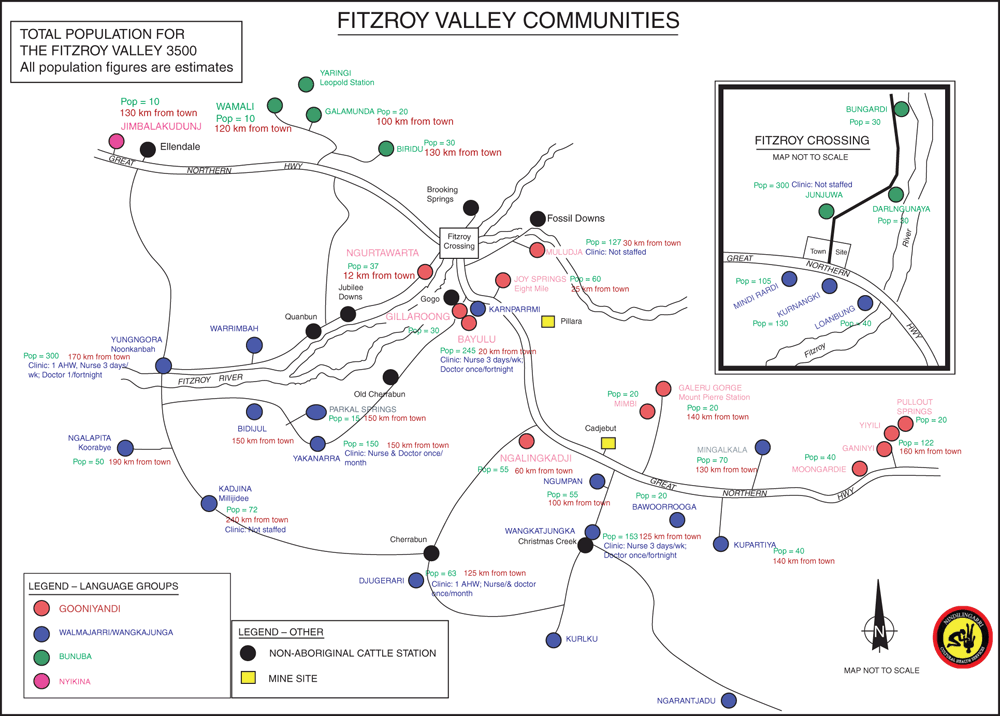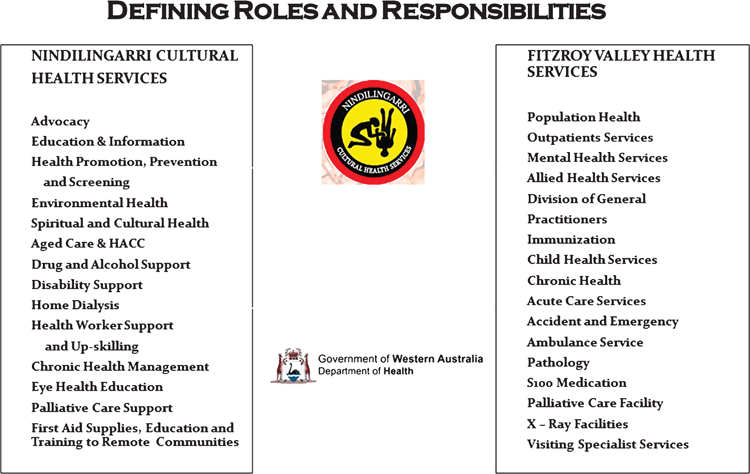Community participation in health service reform: the development of an innovative remote Aboriginal primary health-care service
Carole Reeve A G , John Humphreys B , John Wakerman A , Vicki Carroll C , Maureen Carter D , Tim O’Brien C , Carol Erlank E , Rafik Mansour E and Bec Smith FA Centre for Remote Health, Flinders University and Charles Darwin University, PO Box 4066, Alice Springs, NT 0871, Australia.
B Centre of Research Excellence in Rural and Remote Primary Care, Monash University School of Rural Health, Bendigo, Vic. 3552, Australia.
C Western Australian Country Health Services, Kimberley Population Health Unit, Locked Bag 4011, Broome, WA 6725, Australia.
D Nindilingarri Cultural Health Services, PO Box 59, Fitzroy Crossing, WA 6765, Australia.
E Western Australian Country Health Services, Fitzroy Crossing Hospital, PO Box 5, Fitzroy Crossing, WA 6765, Australia.
F Derby Hospital, PMB 938, Derby, WA 6728, Australia.
G Corresponding author. Email: carole.reeve@flinders.edu.au
Australian Journal of Primary Health 21(4) 409-416 https://doi.org/10.1071/PY14073
Submitted: 17 December 2013 Accepted: 26 September 2014 Published: 29 January 2015
Journal Compilation © La Trobe University 2015
Abstract
The aim of this study was to describe the reorientation of a remote primary health-care service, in the Kimberley region of Australia, its impact on access to services and the factors instrumental in bringing about change. A unique community-initiated health service partnership was developed between a community-controlled Aboriginal health organisation, a government hospital and a population health unit, in order to overcome the challenges of delivering primary health care to a dispersed, highly disadvantaged Aboriginal population in a very remote area. The shared goals and clear delineation of responsibilities achieved through the partnership reoriented an essentially acute hospital-based service to a prevention-focussed comprehensive primary health-care service, with a focus on systematic screening for chronic disease, interdisciplinary follow up, health promotion, community advocacy and primary prevention. This formal partnership enabled the primary health-care service to meet the major challenges of providing a sustainable, prevention-focussed service in a very remote and socially disadvantaged area.
Additional keywords: change management, equity, remote health, sustainable.
| What is known about the topic? |
|
| What does this paper add? |
|
Introduction
Despite a long history of health policies designed to bring about improvements in the health status of remote Aboriginal communities, poor health outcomes persist. Ensuring the provision of sustainable, appropriate health-care services to small isolated communities is challenging (Australian Institute of Health and Welfare 2008; Humphreys and Wakerman 2009). This problem is most acute in remote Aboriginal communities, reflecting both inadequate access to appropriate care and the impact of socioeconomic determinants of health (Australian Institute of Health and Welfare 2010). This case study describes the evolution of a remote area primary health-care (PHC) service and analyses the key factors instrumental in bringing about effective and sustainable changes in health-care provision.
The study area
The Fitzroy Valley in the Kimberley region of Western Australia covers an area of 30 000 km2 with a population of ~3500 people dispersed across 44 communities (Fig. 1). Sixty per cent of the Valley population is Aboriginal, with many of the small communities 100% Aboriginal. The main township, Fitzroy Crossing (population 1600), is centrally located and contains the state government-funded hospital and community clinic, and the Commonwealth-funded Aboriginal community-controlled health service – Nindilingarri Cultural Health Service (NCHS). Compared with the national average, the demographic profile of the Fitzroy Valley population is young, with high fertility, but exhibits a high mortality, especially among adults aged over 40 years due to the high prevalence of chronic diseases (Morphy 2010).
In the 1990s, Fitzroy Valley community members became increasingly concerned about the burden of disease among their families and participated in a 12-month consultation process led by Aboriginal community leaders. This culminated in the establishment of the NCHS in 1995.
For the next 10 years, NCHS provided nurse-led primary care clinics in Fitzroy Crossing and the government hospital provided inpatient and emergency services. In 2004–05, there was a second extensive 2-year period of engagement with the Fitzroy Valley communities, led by community leaders and elders to achieve consensus on how to further improve health services. In what follows, we describe the reorientation of the health-care service, its impact on access to services and the factors instrumental in bringing about change.
Methods
Mixed methods were used over three stages for this descriptive study. First, relevant literature of PHC models in small remote and rural areas and community-controlled health services, (including both peer-reviewed literature and ‘grey’ literature such as government reports and health service documents) was reviewed to develop a conceptual framework against which the change process and sustainability could be analysed. Documents related to the reorientation of health services in the region were also reviewed.
Second, local information was collected through in-depth interviews conducted with key stake-holders and focus groups. Data were grouped thematically and to provide research rigour, the transcripts were independently analysed by two investigators; anomalies were discussed and resolved. Quantitative data (health service utilisation, workforce numbers and composition, and health service availability) were also collected from the health services. Five stake-holder interviews and four focus groups (one in Broome and three in Fitzroy Crossing) were completed. Focus groups comprised health service providers (10 people), health governing council (14 people) and community members associated with the development of the partnership (six people). The focus group and interview analysis identified several key themes as crucial to the success of the change process.
The results of these two processes are described in ‘Primary health realignment: a remote story’ (V Carroll, C Reeve, J Humphreys, M Carter, unpubl. data).
Last, the quantitative and qualitative data collected were collated and analysed by the research team and presented to community and health service leaders in a series of workshops in order to ensure the findings were accurate.
Ethics approval was provided by the Kimberley Aboriginal Health Planning Forum Research Subcommittee, the Western Australian Indigenous Ethics Council and the Western Australian Country Health Service (WACHS) Ethics Committee.
Results
The 2004–05 community-led consultation resulted in a mandate from the community for a partnership between the state health services and the NCHS. The goals were to increase access to services across the Fitzroy Valley and increase community input into how government health services were delivered. The health service vision was to address ‘upstream’ determinants of health by providing health promotion and early intervention services in addition to acute clinical services.
The NCHS approached the Western Australian Country Health Service in the Kimberley (WACHS-K) to form a partnership to enable the two service providers to work together in a more coordinated and integrated way, building on each organisations’ strengths and delineating clear roles and responsibilities in order to minimise service duplication and competition for scarce resources.
An external consultant facilitated discussions over a 2-year period in which each party articulated the services they delivered and funded, as well as round table discussions on the most effective ways to coordinate activities. In 2006, a framework delineating the activities and responsibilities of each service (Fig. 2), together with a supporting governance structure (Western Australia Country Health Service 2006a), were documented in a Memorandum of Understanding (Western Australia Country Health Service 2006b) and a formal Partnership agreement (‘the Partnership’) (Western Australia Country Health Service 2006c). NCHS are the custodians of the Partnership and the Partnership is the executive of the integrated service. The changes required the participation of State and Commonwealth Offices of Aboriginal Health to negotiate new funding models. Three key elements were apparent.
Local community participation Extensive community consultation resulted in trusting relationships and clarity around a shared vision with local health-care providers. This shared vision and the relationships were important in negotiating the roles and responsibilities, and willingness to pool assets for the common good. Local community leadership also provided continuity in an environment characterised by very high staff turnover.
Leadership and vision Committed local leadership was required to overcome the many bureaucratic barriers to new models of care. Both organisations faced significant pressure from funders and external bureaucrats to maintain the status quo during the 2-year negotiation. Alignment in timing with national and state policies provided permission and funding to assist the changes.
Formal partnership The formal documents and Memorandum of Understanding enabled many of the linkages, such as a single shared electronic record and access to Commonwealth funding for primary health care. Co-location provided informal networks and enabled a better understanding of each other’s business and decision-making. Importantly, it facilitated pooling of the limited resources to achieve the critical mass required to provide primary care programs and to minimise the need for separate corporate services.
The analysis also revealed the significant barriers and challenges to change experienced by those involved and are highlighted in the quotes in Box 1.
| Box 1. Quotes describing the achievements and challenges of the change process |
| Through the involvement of Aboriginal people in instigating this partnership, we have been able to form a unique holistic health model. Again, this is a model which represents the Aboriginal view that everything is linked. (NCHS staff) |
| There were also concerns that Nindilingarri would be consumed by Government bureaucracy and red tape. (NCHS staff) |
| Nindilingarri’s priority being Health Promotion did not fit with the Governments current funding guidelines which required immediate data reporting. Our Health Promotion model worked with communities and groups over a period of time, resulting in long term outcomes and results, as opposed to a clinical model which generates instant data. (NCHS staff) |
| This partnership reflects the views of the local community regarding the type of health service they believe best meets their needs, and the way in which ‘mainstream’ services should operate in the Fitzroy Valley. (Community Partnership member) |
| Fundamental to the approach is a commitment to the fact that Aboriginal people and Communities are aware of their own requirements and goals and therefore must be central to any and all decision making processes affecting them. To this end, knowledge and assistance must not work in a manner that overrides or diminishes the processes and outcomes determined by Communities. (Community Partnership member) |
| The emphasis on delivering services tailored to meet the needs of the local community is a fundamental cornerstone of the partnership between the Fitzroy Valley Health Service and Nindilingarri Cultural Health, and will continue to drive our decisions and provide us with direction both now and into the future. (Community Partnership member) |
| Everybody was totally risk averse rather than looking at how to make it work. (Government Partnership member) |
| We bin wait long time for this. (Community Elder) |
The change process
Kotter’s (1995) steps for successful organisational change were used to analyse the change process. Reorientation of health service delivery was closely aligned with known steps for successful organisational change: (i) creating a climate for change, through community participation and leadership; (ii) engaging and enabling the whole organisation, achieved through the formal partnership; and (iii) implementing and sustaining change, through the new integrated health service. The key elements of the change process are summarised in Fig. 3.
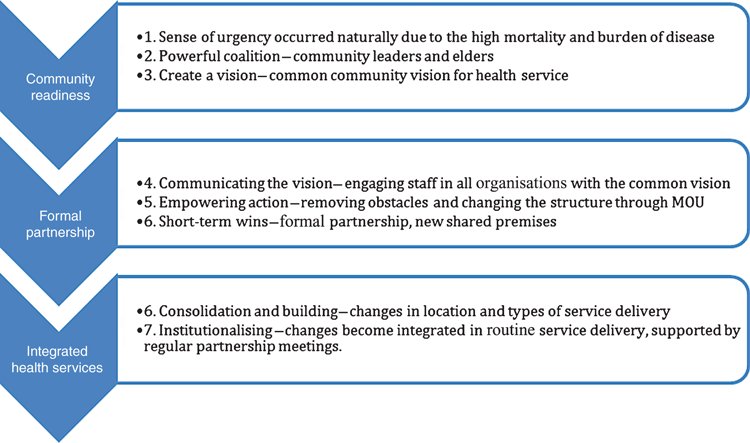
|
Integrated health services and improved access
Structural changes enabled by the delineation of roles and responsibilities through the partnership agreement resulted in tangible changes in service delivery. NCHS relinquished their primary care clinics (staff and buildings) so they could focus on their areas of strength – environmental health, health promotion, cultural safety and advocacy. This more strategic focus resulted in significant achievements, including a smoking cessation program and the implementation of community-led alcohol restrictions (Elliott et al. 2012) and support for the first Foetal Alcohol Spectrum Disorder (FASD) prevalence study (Lillawun) in Australia (Fitzpatrick et al. 2012).
In turn, the consolidation of clinical resources increased primary care access across the valley through increased outreach services. Community nursing clinics became available 4 days a week in three smaller Fitzroy Valley communities with populations of more than 160 people – Bayulu, Noohkanbah and Wankajungka, and monthly services were also available to even more distant satellite communities. In addition, key changes in the hospital included a primary care clinic where non-urgent emergency department patients are seen in a much more comprehensive manner, with a follow up and recall system and regular doctor visits to the community clinics, particularly for the management of complex chronic disease. The partnership also enabled access to medications under section 100 of the National Health Act 1953 for people in the Valley where there are no pharmacies or other access to medications.
Analysis of local service delivery data showed increases in primary care clinic availability across the Fitzroy Valley, particularly in the smaller satellite communities, an increase in Aboriginal staff employed, an increase in the proportion of the budget invested in primary care and increased allied health services and follow up of patients for primary care (Table 1).
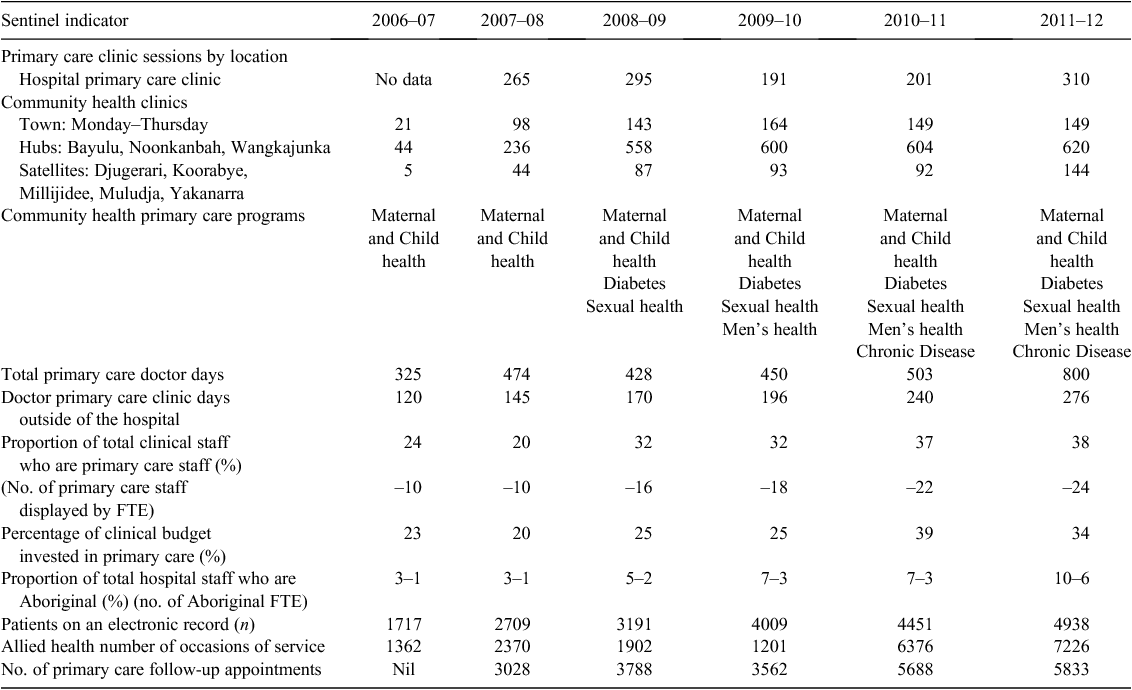
|
Key requirements for sustainability
Exactly what makes rural and remote primary health-care services appropriate, accessible and sustainable is not well documented in the literature (Wakerman et al. 2008). Wakerman and Humphreys (2011) and Buykx et al. (2012) describe key enablers and requirements for the sustainability of PHC services and the resultant evaluation framework has been applied in the field (Wakerman et al. 2009). The framework developed by Wakerman and Humphreys (2011) provided a useful tool for analysing how the Partnership addressed the essential sustainability requirements (Table 2).
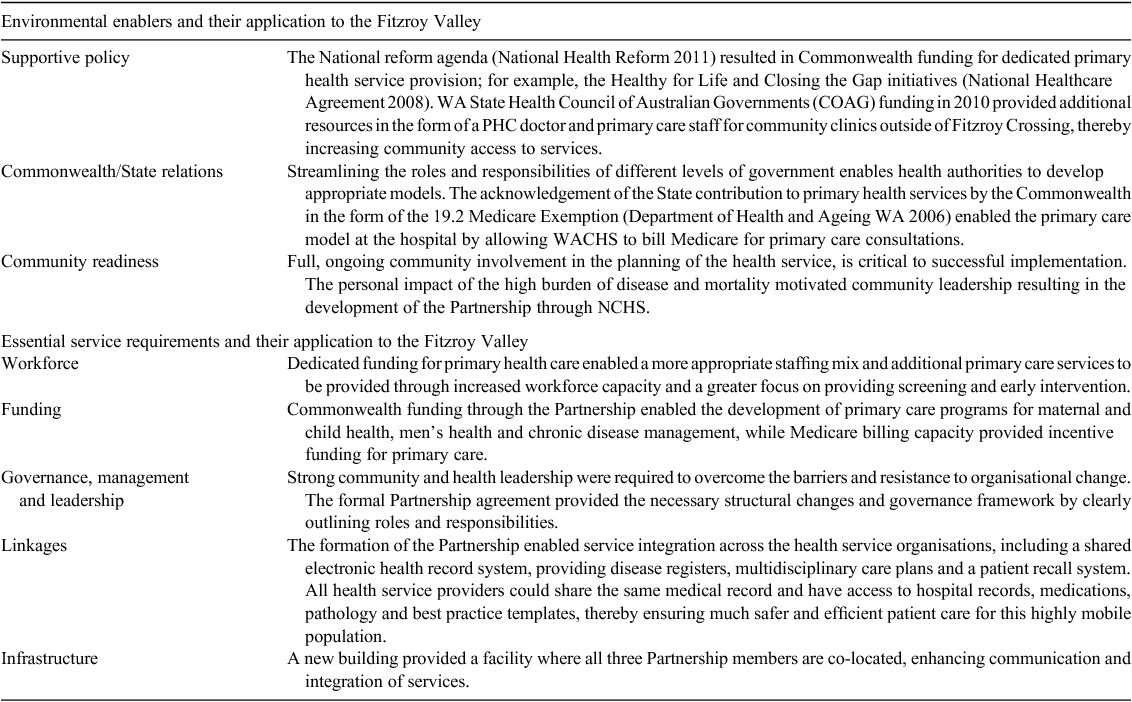
|
Discussion
This case study describes the integration of a remote area health service with a community-controlled health service to strengthen primary care through community participation to achieve increased access to clinical and preventive care. The philosophical change in approach can be described as moving from an acute hospital-based service (waiting for patients to present), to pro-actively delivering appropriate PHC to residents in their communities. This approach includes providing health checks to screen for disease opportunistically when patients present to the hospital emergency department and community clinics, as well as providing interdisciplinary chronic disease management through recalls and booked appointments. New health promotion programs included smoking cessation and combining risk factor screening with health education to increase health literacy.
Three major factors facilitated the change (Fig. 4). First was the strong local community participation in health reform through genuine partnership, as recommended by the National Aboriginal Health Strategy Working Party (1989). Although the right of communities to participate in the planning and implementation of their health care was articulated in the Alma-Ata Declaration (World Health Organization 1978), there is a paucity of literature demonstrating tangible impact on health outcomes (Bath and Wakerman 2013). The evidence around the impact on intermediate outcomes such as access to services, utilisation and quality is stronger in the Aboriginal community-controlled sector (Eckermann et al. 2010) and this study supports this association.
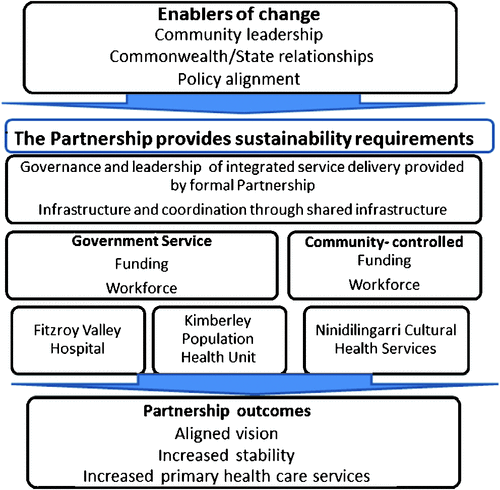
|
Second, the critical factor enabling health service change was the alignment of a strong local community and health service vision with the goals underpinning State and Commonwealth government health policies. The concurrent timing of this alignment facilitated change from the historical hospital-focussed model of service delivery to a stronger preventive focus in the face of considerable bureaucratic resistance.
Last, the Partnership instituted changes in service delivery by making significant structural changes to how, where and who delivered service through engaging staff and consistently reinforcing the changes.
A critical factor in measuring the success of reorientation to a stronger PHC approach is the extent to which it can meet the health needs of the population sustainably. We can be confident of sustainability for several reasons. First, identifying Kotter’s (1995) principles for successful, sustainable organisational change, together with a logic framework that links an improved structure to improvements in process and outcomes (Watson et al. 2009), support our conclusion that the changes described in this case study are sustainable and will improve health outcomes. Second, the new service addressed all of the key sustainability requirements identified in the literature (Labonté et al. 2008; Wakerman and Humphreys 2011). The Partnership also used the strategies recommended by The Steering Committee for Indigenous Health Equality (Chapman 2010), adding to the sustainability of change and likelihood of improved health inequity in the long term. Last, the consistent community leadership shown over the past 20 years and data collected over the past 6 years provide additional evidence supporting the sustainability argument.
Understanding how this innovative PHC service evolved, and the factors instrumental in bringing about integration to a comprehensive PHC service relevant to the local context, provide important insights into the requirements for effective health service change and sustainability for other small disadvantaged communities. This case study highlights what is possible and necessary to deliver appropriate and accessible PHC in communities seeking to align services with local needs.
Conflicts of interest
CR, VC, MC, TO, CE, RM and BS work for the health service.
References
Australian Institute of Health and Welfare (2008) Rural, regional and remote health: indicators of health status and determinants of health, rural health series no. 9. Cat. no. PHE 97. AIHW, Canberra.Australian Institute of Health and Welfare (2010) Australia’s health 2010. Whose health? How population groups vary. Australia’s health no. 12. Cat. no. AUS 122. AIHW, Canberra.
Bath J, Wakerman J (2013) Impact of community participation in primary health care: what is the evidence? Australian Journal of Primary Health
| Impact of community participation in primary health care: what is the evidence?Crossref | GoogleScholarGoogle Scholar | 24176202PubMed |
Buykx P, Humphrey J, Tham R, Kinsman L, Wakerman J, Asaid A, Tuohey K (2012) How do small rural primary health care services sustain themselves in a constantly changing health system environment? BMC Health Services Research 12, 81
| How do small rural primary health care services sustain themselves in a constantly changing health system environment?Crossref | GoogleScholarGoogle Scholar | 22448876PubMed |
Chapman N (2010) Close the Gap Steering Committee for Indigenous Health Equality. Partnership position paper. Available at http://www.humanrights.gov.au/sites/default/files/content/pdf/social_justice/health/partnership_position_paper.pdf [Verified 10 December 2013]
Department of Health and Ageing WA (2006) Memorandum of Understanding Between the Commonwealth of Australia and Western Australia in relation to the cooperative implementation of Council of Australian Governments’ (COAG’S), 10 February 2006, ‘Better access to primary care services in rural areas’ initiative (The ‘19(2) exemptions’ initiative). Available at http://www.amawa.com.au/wp-content/uploads/2013/03/mou_exemption.pdf [Verified 31 October 2014]
Eckermann A-K, Dowd T, Chong E, Nixon L, Gray R, Johnson S (Eds) (2010) ‘Binan Goonj: bridging cultures in Aboriginal Health.’ (Elsevier Australia: Sydney)
Elliott E, Latimer J, Fitzpatrick J, Oscar J, Carter M (2012) There’s hope in the valley. Journal of Paediatrics and Child Health 48, 190–192.
| There’s hope in the valley.Crossref | GoogleScholarGoogle Scholar | 22417462PubMed |
Fitzpatrick J, Elliott E, Latimer J, Carter M, Oscar J, Ferreira M, Olson H, Lucas B, Doney R, Salter C, Peadon E, Hawkes G, Hand M (2012) The Lililwan Project: study protocol for a population-based active case ascertainment study of the prevalence of fetal alcohol spectrum disorders (FASD) in remote Australian Aboriginal communities. BMJ Open 2, e000968
| The Lililwan Project: study protocol for a population-based active case ascertainment study of the prevalence of fetal alcohol spectrum disorders (FASD) in remote Australian Aboriginal communities.Crossref | GoogleScholarGoogle Scholar | 22556161PubMed |
Humphreys J, Wakerman J (2009) Primary health care in rural and remote Australia: achieving equity of access and outcomes through national reform. Available at http://www.health.gov.au/internet/nhhrc/publishing.nsf/content/16f7a93d8f578db4ca2574d7001830e9/$file/primary%20health%20care%20in%20rural%20and%20remote%20australia%20-%20achieving%20equity%20of%20access%20and%20outcomes%20through%20national%20reform%20%28j%20humph.pdf [Verified 22 July 2013]
Kotter JP (1995) Leading change: why transformation efforts fail. Harvard Business Review (March–April) pp. 1–10. Harvard Business School, Boston, MA.
Labonté R, Sanders D, Baum F, Schaay N, Packer C, Laplante D, Vega-Romero R, Viswanatha V, Barten F, Hurley C, Ali HT, Manolakos H, Acosta-Ramírez N, Pollard J, Narayan T, Mohamed S, Peperkamp L, Johns J, Ouldzeidoune N, Sinclair R, Pooyak S (2008) Implementation, effectiveness and political context of comprehensive primary health care: preliminary findings of a global literature review. Australian Journal of Primary Health 14, 58–67.
| Implementation, effectiveness and political context of comprehensive primary health care: preliminary findings of a global literature review.Crossref | GoogleScholarGoogle Scholar |
Morphy F (2010) Population, people and place: the Fitzroy Valley population project, CAEPR working paper no. 70. Available at http://caepr.anu.edu.au/sites/default/files/Publications/WP/CAEPRWP70.pdf [Verified 22 June 2013]
National Aboriginal Health Strategy Working Party (1989) A national Aboriginal health strategy. (Australian Government Department of Health and Ageing: Canberra) Available at http://www.health.gov.au/internet/main/publishing.nsf/Content/health-oatsih-pubs-NAHS1998 [Verified 12 December 2013]
National Health Reform (2011) Improving primary health care for all Australians: Commonwealth of Australia. Australian Government Department of Health and Ageing, National Health Reform. Available at http://www.yourhealth.gov.au/internet/yourhealth/publishing.nsf/Content/improving-primary-health-care-for-all-australians-toc [Verified 17 December 2013]
National Healthcare Agreement (2008) National partnership agreement on closing the gap in indigenous health outcomes. Australian Government Department of Families, Housing, Community Services and Indigenous Affairs. Available at http://www.fahcsia.gov.au/our-responsibilities/indigenous-australians/programs-services/closing-the-gap/closing-the-gap-national-partnership-agreements#a [Verified 17 December 2013]
Wakerman J, Humphreys J (2011) Sustainable primary health care services in rural and remote areas: Innovation and evidence. The Australian Journal of Rural Health 19, 118–124.
| Sustainable primary health care services in rural and remote areas: Innovation and evidence.Crossref | GoogleScholarGoogle Scholar | 21605224PubMed |
Wakerman J, Humphreys J, Wells R, Kunipers P, Entwistle P, Jones J (2008) Primary health care delivery models in rural and remote Australia – a systematic review. BMC Health Services Research 8, 276
| Primary health care delivery models in rural and remote Australia – a systematic review.Crossref | GoogleScholarGoogle Scholar | 19114003PubMed |
Wakerman J, Humphreys J, Wells R, Kuipers P, Jones J, Entwistle P, Kinsman L (2009) Features of effective primary health care models in rural and remote Australia: a case-study analysis. The Medical Journal of Australia 191, 88–91.
Watson DE, Broemgeling A, Wong ST (2009) A results-based logic model for primary healthcare: a conceptual foundation for population-based information systems. Healthcare Policy 5, 33–46.
Western Australia Country Health Service (2006a) The Fitzroy Valley Health Partnership. Operational Management Team Terms of Reference. Department of Health Western Australia, Perth.
Western Australia Country Health Service (2006b) The Fitzroy Valley Health Partnership Memorandum of Understanding. Department of Health Western Australia, Perth.
Western Australia Country Health Service (2006c) The Fitzroy Valley Health Partnership Agreement. Department of Health Western Australia, Perth.
World Health Organization (1978) Declaration of Alma-Ata. International Conference on Primary Health Care, 6–12 September 1978, Alma-Ata, USSR.


